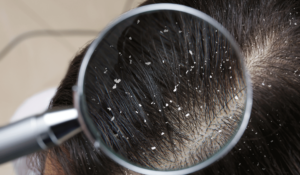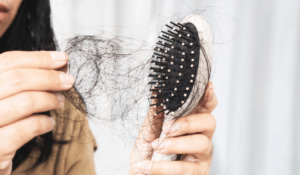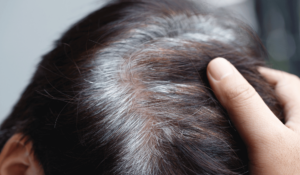Hair
Hair | Dr. Mahmood Yunus Usmani
Hair Disorders
Dermatological rejuvenation procedures

Dandruff is a common scalp condition characterized by flaking and itching. It affects approximately 50% of adults worldwide.
Causes:
Dandruff may result from several factors:
Irritated, oily skin (seborrheic dermatitis) Dry skin
A yeast-like fungus (Malassezia) that feeds on oils on the scalp
Sensitivity to hair care products (contact dermatitis)
Other skin conditions, such as psoriasis and eczema
Symptoms:
Common signs include:
White or yellowish flakes on the scalp, hair, or shoulders
Itchy scalp
Red and greasy patches of skin
A tingling sensation on the scalp
Prevention:
To minimize dandruff:
Maintain a regular hair-washing routine to remove excess oil and skin cells
Use gentle hair care products to avoid irritating the scalp
Manage stress, as it can trigger or worsen dandruff
Eat a balanced diet rich in zinc, B vitamins, and certain fats to support skin health
If dandruff persists or worsens, consult a healthcare professional for appropriate management.

Hair fall, medically known as alopecia, is a prevalent condition affecting individuals across various age groups. It involves the shedding of hair from the scalp or other body parts, which can be temporary or permanent.
Causes:
Hair fall can result from multiple factors:
Genetic Predisposition: Hereditary conditions like male-pattern or female-pattern baldness.
Hormonal Changes: Events such as pregnancy, childbirth, menopause, or thyroid problems.
Medical Conditions: Diseases like alopecia areata, scalp infections, or disorders like lupus.
Medications and Supplements: Drugs used for cancer, arthritis, depression, heart problems, and high blood pressure.
Physical or Emotional Stress: Significant stress can lead to temporary hair loss.
Nutritional Deficiencies: Lack of essential nutrients like protein, iron, and vitamins.
Symptoms:
Signs of hair fall include:
Gradual Thinning on Top of Head: The most common type of hair loss, affecting both men and women as they age.
Circular or Patchy Bald Spots: Some people experience smooth, coin-sized bald spots.
Sudden Loosening of Hair: A physical or emotional shock can cause hair to loosen.
Full-Body Hair Loss: Some conditions and medical treatments, like chemotherapy, can result in the loss of hair all over your body.
Prevention:
While not all types of hair loss can be prevented, the following measures may help:
Gentle Hair Care: Avoid tight hairstyles and harsh treatments.
Balanced Diet: Ensure adequate intake of essential nutrients.
Stress Management: Practice relaxation techniques to reduce stress levels.
Regular Health Check-ups: Monitor and manage underlying health conditions.
If you notice unusual hair loss or thinning, it’s advisable to consult a healthcare professional for proper evaluation and guidance.

Premature greying of hair refers to the early onset of grey or white hair, occurring before the typical age range—before 20 years in Europeans, 25 in Asians, and 30 in Africans. This condition can affect self-esteem and may be influenced by various factors.
Causes:
Genetic Factors: A primary cause, where family history plays a significant role in early greying.
Nutritional Deficiencies: Lack of essential nutrients like vitamin B12, iron, copper, and vitamin D can contribute to premature greying.
Oxidative Stress: An imbalance between free radicals and antioxidants in the body can damage melanocytes, the cells responsible for hair pigmentation.
Smoking: Associated with increased oxidative stress, leading to damage of melanin-producing cells and early greying.
Stress: Chronic stress may lead to the depletion of melanocyte stem cells, resulting in loss of hair pigmentation.
Medical Conditions: Disorders such as thyroid dysfunction or autoimmune diseases can be linked to premature greying.
Symptoms:
Appearance of grey or white strands mixed with natural hair color at an early age.
Progressive increase in the number of grey hairs over time.
Possible association with other signs of aging or underlying health issues.
Prevention:
Balanced Diet: Ensuring adequate intake of vitamins and minerals to support melanin production.
Healthy Lifestyle: Avoiding smoking and managing stress through relaxation techniques.
Regular Health Check-ups: Monitoring for and addressing any underlying medical conditions that may contribute to premature greying.
While premature greying is often influenced by genetics, adopting a healthy lifestyle may help delay its onset. If concerned about early greying, consulting a healthcare professional can provide personalized guidance.
About Hair
Hair is an integral part of the integumentary system, serving both functional and aesthetic roles. It provides protection, regulates body temperature, and enhances sensory perception. Hair follicles, located in the dermal layer of the skin, are responsible for hair growth and play a role in skin repair and regeneration.
At Usmani’s Clinic, we understand that hair health is a reflection of overall well-being. Common hair issues include hair loss, dandruff, dryness, and scalp infections. These conditions can result from various factors such as genetics, hormonal imbalances, nutritional deficiencies, stress, and environmental exposures.
Maintaining healthy hair involves a balanced diet, proper hygiene, and regular care. Early detection and management of hair problems are crucial to prevent long-term damage and restore hair vitality. Our clinic is dedicated to providing comprehensive care tailored to individual needs, ensuring optimal hair and scalp health.
Causes of Hair Issues
Several factors can lead to hair problems:
Genetics
Inherited conditions like male or female pattern baldness can cause gradual hair thinning.Hormonal Imbalances
Changes during pregnancy, menopause, or thyroid disorders can disrupt hair growth cycles.Poor Nutrition
Deficiencies in protein, iron, zinc, and vitamins (especially B12 and D) can weaken hair structure.Stress and Lack of Sleep
Chronic stress or insufficient rest can trigger telogen effluvium, leading to temporary hair sheddingMedical Conditions
Autoimmune diseases like alopecia areata, scalp infections, or chronic illnesses can affect hair health.Medications and Treatments
Certain drugs, including chemotherapy agents, antidepressants, and blood pressure medications, may cause hair loss.Chemical and Heat Exposure
Frequent use of dyes, perms, straighteners, or heat styling tools can damage hair shafts and follicles.Tight Hairstyles
Styles that pull on the hair, such as tight ponytails or braids, can lead to traction alopecia.Environmental Factors
Exposure to pollutants, UV radiation, or harsh weather conditions can degrade hair quality.
Understanding these causes is essential for maintaining healthy hair and preventing further issues.
Symptoms of Hair Issues
Thinning Hair
Receding Hairline
Bald Patches
Excessive Shedding
Itchy or Irritated Scalp
Dry or Flaky Scalp
Changes in Hair Texture
Loss of Eyebrows or Eyelashes
If you’re experiencing any of these symptoms, it’s advisable to consult a healthcare professional for proper evaluation and guidance.
Treatments
Contact Us
- Shah Market Opp. PNB bank, Shahbad Gate, Rampur U.P 244901
- +91 99274 25447
- iinfo@drmyu.com
